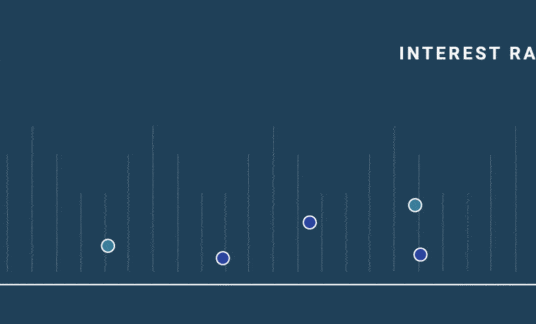Raising prices is a strategy many businesses have implemented from time to time, whether out of a desire for additional profits or sheer necessity. Rising inflation is one reason business owners have recently resorted to this measure.
In an attempt to counteract the effects of inflation, 67% of small businesses have raised prices, according to the U.S. Chamber of Commerce. Similarly, a recent SCORE survey found that 54.8% of small businesses have already raised (or plan to raise) prices to match price increases in the market and improve profitability.
SCORE also found that the greatest percentage of businesses increased prices by 10%-15%. Among surveyed businesses, the average price increase was 11%.
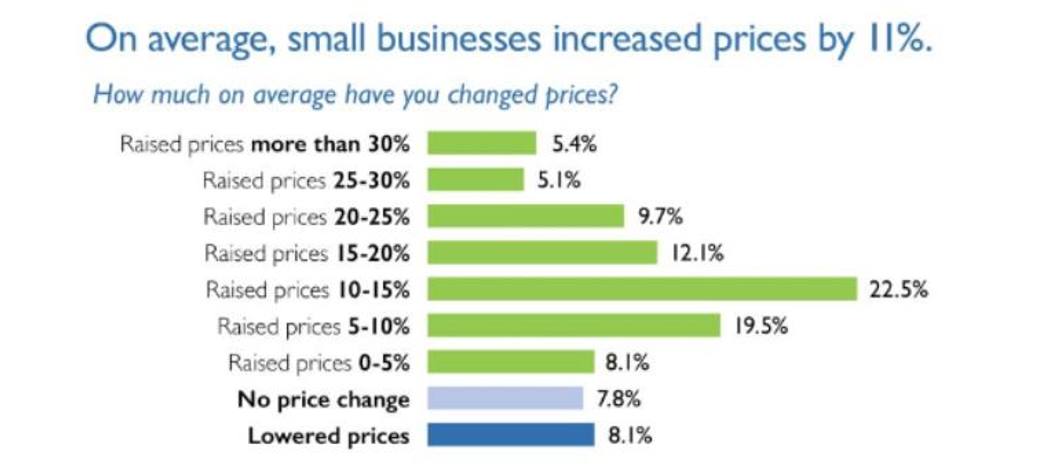
Source: SCORE
How can you communicate a price increase to your customers? Check out these tips and examples demonstrating a few tried-and-true ways to announce price changes effectively.
Tips for Communicating Price Increases In Writing
As you’re crafting your own template for a price increase letter to customers, here are a few tips to keep in mind.
Provide Lead Time
You don’t want to spring a price increase on your customers. Give them sufficient advance notice so they can prepare their budget for the change.
You might also encourage them to take advantage of your products or services before the price increase goes into effect. Consider providing a special offer to ease in the transition or a price lock-in option before changes take effect.
Highlight Positives
Be sure to highlight the positives about your company, products and services that your users have come to appreciate. Also, consider mentioning what will remain unchanged in spite of the price increase.
Give a Reason
If your price increases are due to a specific event, such as renovations, inflation, supply pricing increases, shipping rate hikes, operating cost increases or another specific factor, note that in the communication. Such transparency will elicit trust and help customers justify the rising rates.
Specify Changes
If price increases are for a specific product or service, be sure to communicate that to your customers and explain how the change will affect them. If price increases are a percentage across the board, note that instead — for instance, a 10% flat increase on all products and services. Also, indicate when the new pricing will go into effect.
Reiterate Your Value
Reiterate your commitment to your customers. Let them know you’re dedicated to providing the same (or better) quality you’ve always offered.
Thank Customers
Be sure to close with a thank you. Express your gratitude for your customers’ patronage and support. You may also choose to include a link or contact information if there are any questions.
Price Increase Communication Examples
Here are several price increase emails sent by companies in 2022. View samples of subscription, product and flat-price increase communications from large corporations and local companies.
1. Netflix
One of the companies that decided to send out price increase communications in 2022 was Netflix. You may have received an email in your inbox with the subject line “We’re updating our prices – here’s why.”
The email opened with the headline “Updating prices to bring you more.” This was followed by a few paragraphs providing the new price and the date the increase would take effect. There was a brief explanation of the value the price increase would provide viewers as well as links to the Help Center, Contact Us page and Account page. The closing copy was a brief thank-you message.
After the body of the message were a few image clips suggesting Recently Added and Coming Soon shows (which seemed to be dynamically chosen based on watch history) as well as a link to view all shows and movies.
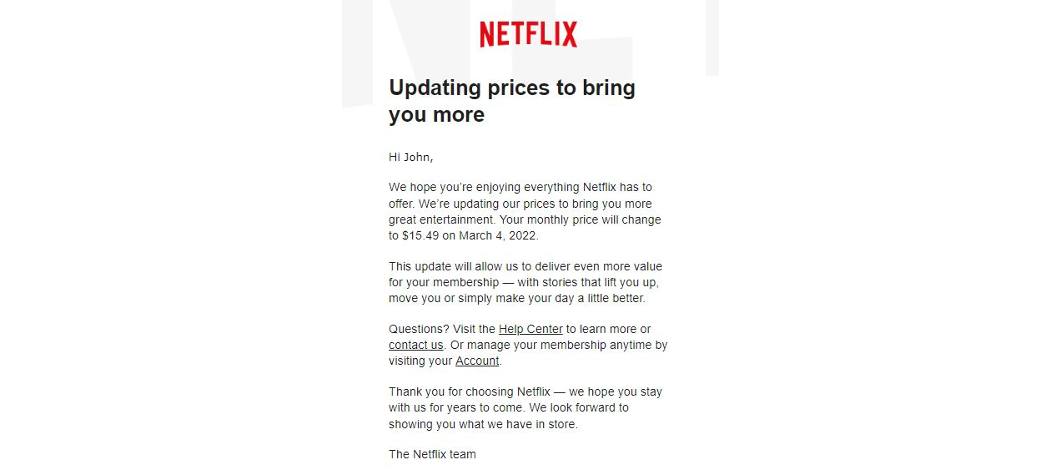
2. Ancestry
Ancestry communicated pricing increases in a September 2022 email with the subject line “Upcoming changes to your pricing.”
In 4 paragraphs, the company communicated the adjustment in price and the date the change would take effect. It noted the last time prices went up (2013) and detailed the current and future value to users.
The email also provided an option for users to explore other membership plans or cancel. It also included links to the Account Settings and Contact Us pages.
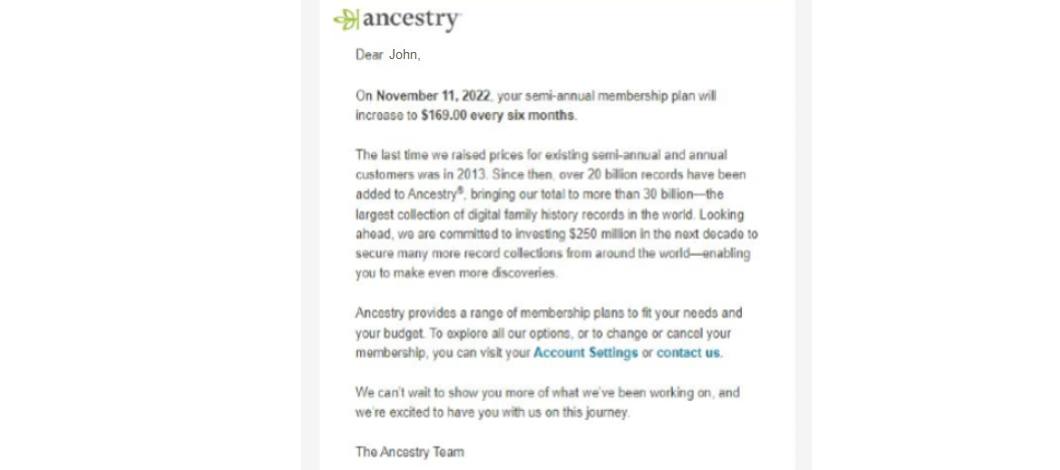
3. Amazon
Another technique for communicating a price increase to customers is showing them a limited-time offer vs. what they’d normally pay (or what the price will increase to once the offer expires).
Amazon, for example, sent an email to Alexa customers with the subject line “Last Chance: $0.99 Sengled Smart Bulb, only with Alexa.”
When you opened the email, the original price was crossed out with the limited-time price enlarged. This was, a clever way to communicate a price increase with just a few words.
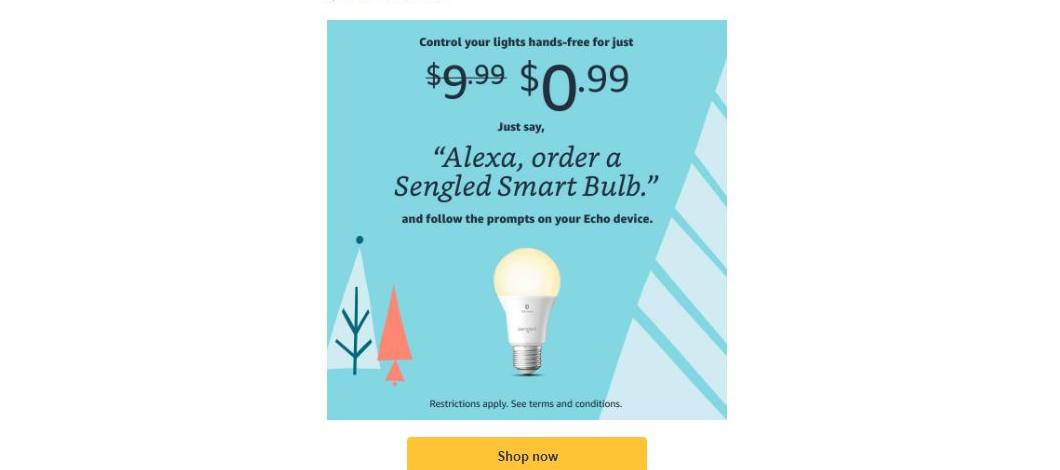
4. Wild Styles Hair Salon
This email from a local hair salon began with a succinct subject line, “Pricing.” The body of the email began thanking customers for their loyalty and positive customer reviews since the business opened its doors.
It then went on to note that due to the rising costs of hair products and cleaning supplies, they will need to slightly increase pricing across the board, with most services increasing by $1.
The email went on to give readers a date when the changes would go into effect and closed with a thank you.
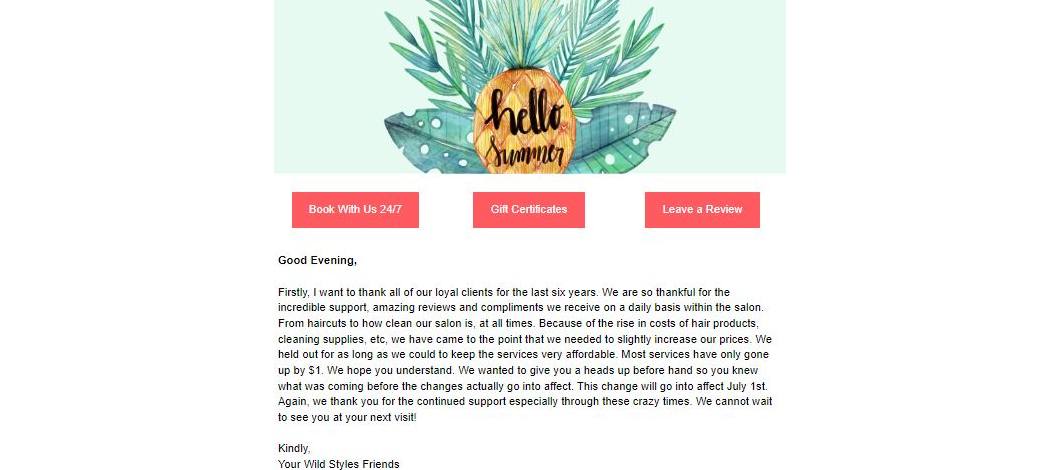
5. ProFlowers
This ProFlowers email began with the subject line “FINAL HOURS! Prices for Christmas gifts are going up tomorrow!”
Instead of relying on heavy copy, the body of the email focused on effective headlines to convey the intended message.
To encourage shopping before the price increase, the company offered a limited-time promotional discount as well as a free gift with purchase. A clickable “Shop Now” button was included to immediately connect users to the website.
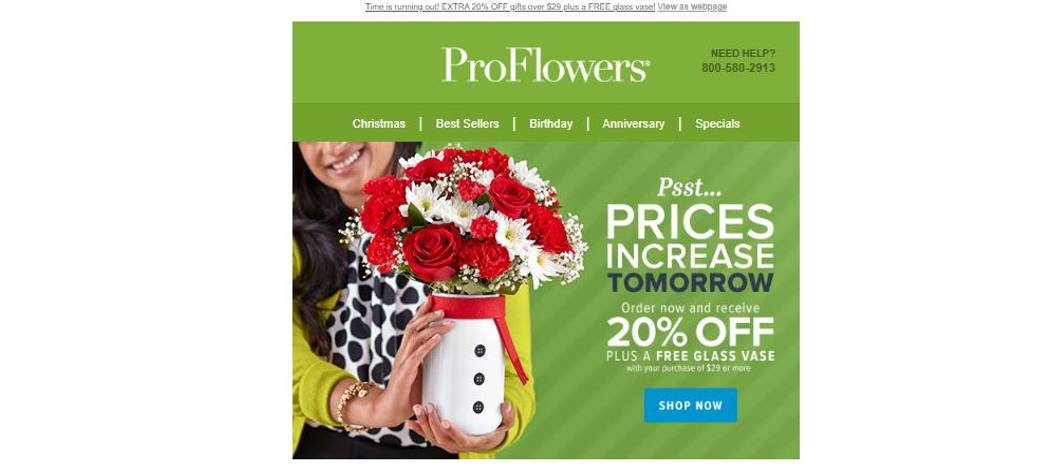
At the bottom of the email were images of several “handpicked” items listing the original price (or what the price would revert back to after the special), which was crossed out, followed by the special price and buttons to order now.
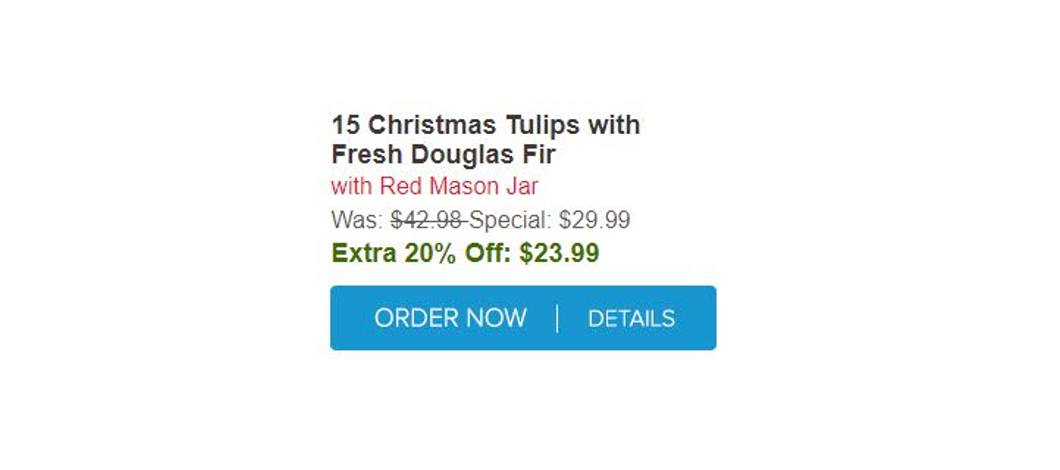
6. Realtor.com
This Realtor.com email’s subject line was “Price Increase in [City, State].” Opening the email, the heading “Prices are going up” was set in bold font. The copy was a simple call to action, “Check out the latest price increase in your [city] search and move fast on places you love.”
An image and brief specs of a featured property in the targeted search area take center stage. Below a link to account settings is included in case the user would like to update search preferences, followed by a link to search more properties in the targeted city.
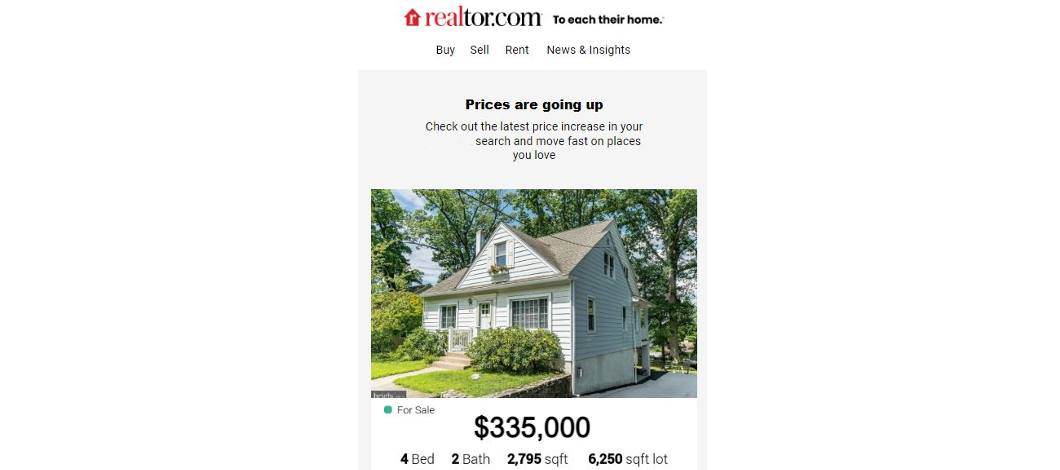
Price Increase Letter Template
You could certainly follow suit using the above sample communications, adjusted to the specifics of your business. However, if you’d prefer a clearer outline, here are several price increase letters to customers in template form so you can personalize them to your company’s needs.
-
Dear/Hi/Hello [First name],
We feel fortunate to have you as a customer. To continue providing you with the same quality and service you’ve come to expect from us, we will need to implement a pricing increase of [dollar amount or percentage] on [product(s) or service(s)], effective [date].
This increase is due to [reason]. Please know that we’ve made every effort to keep this increase to a minimum and will continue to honor current prices until the new effective date.
We appreciate your business and thank you for your continued support.
If you have any questions, please don’t hesitate to reach out.
[Company Name]
-
Dear/Hi/Hello [First name],
Given [reason for price increase], effective [date], the price of our [product(s) or service(s)] will increase [dollar amount or percentage].
As always, we are grateful for your business and remain committed to providing you with quality products and superior service.
For more information about this change or if you have any questions, please do not hesitate to contact us [include contact link or phone number].
[Company Name]
-
Dear/Hi/Hello [First name],
We are writing to inform you of an upcoming price change to [product or service offering(s)].
What does this mean for you?
[Use bullet points to indicate specific price increase and effective date; specify product(s) or service(s) being impacted if not already stated]
What’s the reason for this change?
[Give reason in bullet point format]
What benefits will remain the same?
[Bullet point benefits and value points that will not be affected]
Thank you for choosing [Company Name]. We value your ongoing support and appreciate your understanding.
For any questions, please don’t hesitate to contact us [include link or phone number].
[Company Name]
Email vs. Letter Price Increase Communication
If your price increase letter is for an email communication, consider including links to the account home page, help center, contact page or customer service department if available.
The subject line is another consideration with emails. Examples of subject lines you could use include:
- Pricing increase
- Changes to pricing
- Pricing updates
- Upcoming changes to pricing
- Last chance: [brief details of pricing increase]
- Ending soon: [brief details of pricing increase]
When it comes to written letters, instead of closing the communication with the company name, you may choose to include the name and title of the president, CEO or COO instead, along with their signature.
Additionally, if you’re a small business with a physical site, you might post the price increase in your store and include a reason for the change. For instance, some restaurants have posted notes on their menus indicating the general price increases due to rising food costs.
However you choose to communicate your price increase, be direct, honest and appreciative. Your customers will do the rest.



